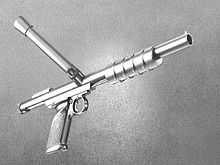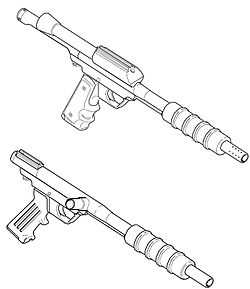CCI Phantom
| Specifications | |
|---|---|
| Type | Mechanical |
| Action | Pump Action |
| Barrel | 6–14 inches |
| Bore | .691 |
| Rate of fire | Limited |
| Retail price | $180+ |
The CCI Phantom is a Nelson-based pump action paintball marker developed and produced by Mike Casady. Production of the Phantom began in 1987 after about six months of prototype work. The name for the marker was derived from the much more stealth-oriented and drawn-out style of play that was typical when the game was first developing. The Phantom was originally designed to be powered by a single 12 gram CO2 powerlet, but larger tanks may also be used by removing the powerlet adapter or using a dummy powerlet. When first introduced the marker featured a fixed barrel assembly referred to as a "unibody" combined with a modified Crosman air pistol frame and brass bead sight.[1] However, since roughly 1989 the body and barrel of the marker have been two distinct parts and no longer feature the bead style sight. The marker is also capable of supporting bulk gravity fed hoppers by using a different breech type. The Phantom is recognized as an extremely versatile marker because of the many possible configurations and is also one of only a handful of readily available markers acceptable for use in the various forms of stock class paintball. However, because the Phantom is capable of auto-triggering and features barrel porting it is considered to be a modified stock class marker.[2]
Component Concepts, Inc. (CCI) is located in Newberg, Oregon and was originally founded in 1979 to provide product design assistance and manufacturing expertise, namely, in dental equipment design.[3]
Operation

Compressed gas enters the valve of the Phantom, pressing the cup seal assembly against the retainer with the aide of the valve spring. This gas forces the valve to stay sealed and allows the gun to be cocked which prepares the hammer of the paintball marker for firing. Without the pressure of the gas in the valve the gun cannot be cocked. As indicated by the term pump action the first step in firing the marker is the pump stroke which uses the rod connecting the pump handle and bolt to cock the marker. The pump stroke consists of two parts; the backward pump stroke and the forward pump stroke. On the backward pump stroke the bolt moves back, compressing the main spring until the bolt and hammer are connected by the sear. At this time a single ball drops into the breech. Next, during the forward pump stroke, both the bolt and hammer move forward, chambering the paintball sealing the breech. Next, as the trigger is pulled, the sear pivots and releases the hammer from the bolt. The compressed main spring forces the hammer back until it reaches the rear of the power tube and provides enough energy to force the power tube back. As the power tube is pushed back the valve opens and compressed gas flows through the power tube and the tuned port compensator (TPC), projecting the paintball out of the barrel.
Design

The term Nelson-based lends itself from the Nelson Paint Company and its first marker, the Nel-Spot 007.[4][5] The basic valve design found in these early markers laid the groundwork for many other manufacturers, including CCI, to develop their own paintball guns. The Nelson design is in-line which means that the bolt, hammer, and valve follow the barrel and form a line as opposed to being stacked.[6] It fires from a closed bolt position meaning that when it fires the bolt is secured into the breech end of the barrel with a paintball loaded.[7] In comparison, the bolt in an open bolt marker is not secured until the marker fires, at which point the paintball is chambered, fired, and the bolt is then re-opened. There is no evidence showing that either design is more or less efficient than the other in the sport of paintball.[8] Another characteristic of the Phantom that varies within the Nelson-based family of markers is that it features the original breech drop design as opposed to the bore drop variation of the design, meaning that the paintballs drop into breech, or rear of the barrel, rather than dropping into the bore of the barrel.[9] Again, there is no evidence showing that one variation is noticeably superior to the other in this case.[10]

Variants
While keeping in mind the basic internal structure of the Phantom paintball marker, there are many different configurations that change the way the marker looks and feels. Different breech layouts allow players to use larger hoppers that are more common among contemporary semi-automatic markers or horizontal feed tubes. There are two general styles available for the Phantom; gravity feed and stock class. Another feature of the Phantom which may differ depending on user preference is the grip frame. The two most common grip frames available for the CCI Phantom paintball marker are the .45 style and M-16 style. The .45 is an offshoot of the common grip structure for handguns chambered for the .45 ACP pistol cartridge such as the M1911 Colt pistol. However, the .45 grip frame is a purely visual replica of its firearm relative as the Phantom cannot be fed by a magazine. The standard grip on the .45 grip frame is the government model rubber grip with finger grooves produced by Hogue Inc.[11] The M-16 style grip frame is derived from the structure of the rifle of the same name, the M-16 rifle, the grip used in the Phantom is produced by Ram-Line and is made of plastic. What also varies is the power source that the Phantom uses. The two main ones are 12 gram powerlets filled with CO2 or a person can use a tank either filled with CO2 or compressed air.
Aesthetics
Due to its simplistic design, the Phantom provides the possibility for a high degree of customization with very little inherent conflict between form and function. Most of the varying setups available for the Phantom can be modified and personalized in order to make the marker unique with various sub-configurations such as "Island" style (The tank is run from the bottomline, however, it is reversed). In addition to the more practical variations and modifications that can be custom tailored for each player by a dealer or an airsmith there are a few purely aesthetic alterations that are popular. Because the body of the Phantom is aluminum the popularity of anodizing has superseded powder coating as the preferred method for imparting a more customized appearance.
The first Phantom Revolution

The original Phantom Revolution was an unfinished semi-automatic paintball marker developed during the early 1990s. It featured an electrically powered rotary breech which was activated by an on-board computer system and microphone which responded to the sound of the marker being fired. Another notable innovation in the Revolution was its boltless design. The breech, which rotated on an axis in a similar fashion to that of the cylinder of a revolver, allowed a paintball to be fed into the breech which would then align with the firing chamber, creating a seal. The maximum rate of fire was 7 balls per second, or 14 with a two-hole breech.[12] A few working prototypes were demonstrated at the 1996 National Professional Paintball League World Cup in Orlando, Florida by Mike Casady.[13] However, production was halted indefinitely in 1996 due to a technical problem with the motor pinion drive. Additionally, there were several markers being produced or developed at the time which used a switch for a trigger and a circuit board to control the feed and/or the pneumatic firing sequence such as the Smart Parts Shocker. The sport of paintball itself saw explosive growth during this decade and as the industry became more lucrative, many patent disputes and lawsuits occurred. CCI effectively sidestepped them by focusing solely on the pump paintball market. All together enough parts for 50 prototypes were fabricated, 12 were assembled,[14] and all but two have been accounted for by Casady.
The production Phantom Revolution
Around 2012, a pump-action marker was released under the Phantom Revolution moniker. It differs significantly from the 1996 prototypes, and is essentially a MQ-valved inline with an independent bolt.
References
- ↑ Stock Class - Phantomonline.com
- ↑ StockClassPaintball.com FAQ
- ↑ E-mail Interview October 12, 2005
- ↑ Digest of Paintguns - WARPIG.com
- ↑ Patent#:3788298 Compressed gas gun with trigger operated hammer release latching structure
- ↑ Paintgun Valves - Structure and Operation - WARPIG.com
- ↑ Rec.Sport.Paintball - FAQ - WARPIG.com
- ↑ Closed Bolt vs. Open Bolt - WARPIG.com
- ↑ How Nelson Paintball Guns Work
- ↑ Bore Drop vs Breech Drop
- ↑ Govt. Model Rubber grip with Finger Grooves - Hogue Inc.
- ↑ http://www.vintagerex.com/museum/showmore/CCI%20-%20Component%20Concepts/Phantom%20Revolution.html
- ↑ NPPL 1996 World Cup - Vendors
- ↑ http://www.vintagerex.com/museum/CCI%20-%20Component%20Concepts/Phantom%20Revolution.html
External links
- The CCI Phantom Homepage
- The Phantom Owners Group
- Phantom Users Manual
- How Nelson Paintball Guns Work
| ||||||||||||||||||||||||||||||||||||||||||||||||||||